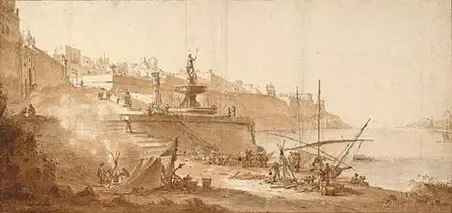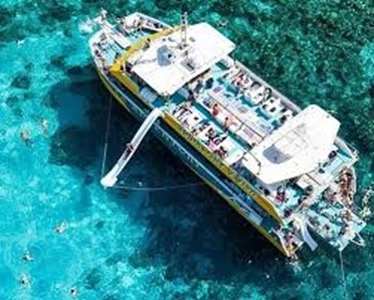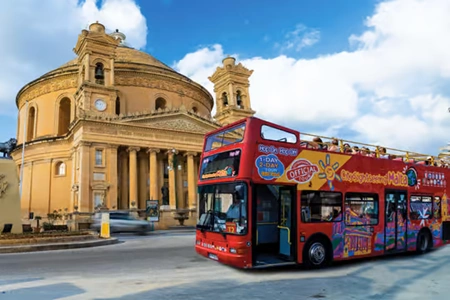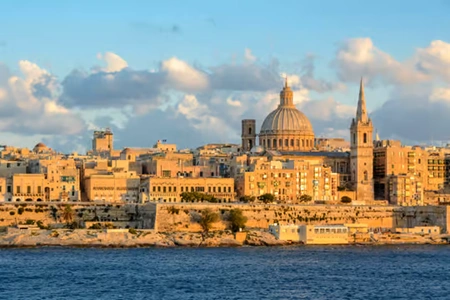Fort Ricasoli
Upon entering the Grand Harbour there is a peninsula (opposite Fort St. Elmo) origally known as Rinella Point or Punta Sottile.
App info: In our app you will find the location, address, opening hours and admission / entrance fee of this spot. If you use the app, you will find additional information and news about this spot on this page.
In 1531 a slavic uprising took place. The purpose of the slaves was to take Fort St. Angelo and to escape from Malta. The uprising was stopped and two leaders and 10 slaves, who had played a role in the uprising, were tortured and then hung visibly at Rinella Point. In this way everybody could see what the consequences would be of such acts.
The Ottomans (Turks) used Rinella Point during the Great Siege in 1565 to set up artillery battery to bomb Fort St. Elmo.
In 1602 a small semi circular battery was built which was known as San Petronio Battery. A tower was built near the artillery battery in 1629. The most important reason for building the tower was to prevent the slaves escaping from the island.
The Italian Knight Alessandro Orsi financed the tower and so it was called Orsi Tower. The official name however was Torre San Petronio but also known as Torre De Falcha (tower of the gallows).
During a storm in February 1821 the artillery battery as well as the tower were destroyed. Because of the moat the location is still recognizable (not accessible).
The artillery battery was protected by a moat filled with seawater and a drawbridge. The tower was covered outside with natural clay and gave the tower a yellow colour. The whole thing was then known as Orsi Point.
In 1964 the Dutchman Willem Schellinks made a drawing of the Grand Harbour. On the drawing you can see the tower and the artillery battery on the far right.
In 1644 Giovanni de’Medici suggested that a new fort should be built at Orsi point and then move all materials and troops from Fort St. Angelo to Birgu to the new fort. This plan was never realized.
In 1669 the Order expected the Ottomans to attack Malta again. The Order invited military engineer Antonio Maurizio Valperga of the House of Savoy to make a plan to improve the fortifications. Valperga made the design for a fort near the location of Orsi Point. The first stone was laid on 15th June 1670 and Valsperga was personally in charge of the guidance. The biggest fort of Malta (Ricasoli) was put into service with limited manpower in June 1674. The Florentine Knight Fra Giovanni Francesco Ricasoli donated a considerable sum of money. The fort was named Ricasoli.
Based on a proposal by the Flemish engineer Carlos de Grunenbergh a number of changes were made in 1681.
During 1680 – 1690 several extensions have been built, like a chapel, barrack, kitchen, etc.
The fort was officially completed in May 1698 and was armed and manned.
Trio Charles Francois de Mondion, Jacob de Puigirand De Tigné and Philippe de Vendôme, all French engineers / architects had serious doubts about the effective functioning of the fort’s bastions. Vendôme suggested making a moat all around it. De Tigné proposed modifications to the loopholes, parapets and extension within the Fort. The plans of De Tigné were realized in 1722, the plan of Vendôme did not have sufficient financial resources available and was not realized, even later.
Around 1700 the fort was in a bad condition and it was only in 1761 that some maintenance took place.
In 1785 Fort Ricasoli was provided with eighty canons of which forty-one were 24 pounder canons. Fort Ricasoli was the most heavily armed fortress.
In 1790 the fence was rebuilt under supervision of the French military engineer Antoine Étienne de Tousard.
In June 1798 Napoleon attacked Malta. At that moment the fortress was only occupied by a volunteer garrison light infantry. It was attacked three times during a short period and managed to repel these attacks.
Grandmaster Hompesch capitulated to Napoleon and Fort Ricasoli fell into French hands.
During the presence the canons of the French shot at the Maltese rebelling and blocking them and especially the Maltese rebels who occupied the San Rocco artillery battery at a distance of 700 m.
When the French were chased away with the help of the English in 1800, the British period started.
The British army placed the Froberg regiment in the Fort. This regiment was recruited from various nationalities like Albania and the Ottoman Empire. The regiment was not satisfied with with their salary and rank. An uprising (mutiny) took place on the 4th April 1807. During the the uprising the gunpowder depots were blown up and the fort was damaged.
The mutiny was defeated on the 12th April. The leaders were executed.
In the 19th century the fort was also used as a military hospital.
In the Second World War the fort was used and also damaged by bombardments.
In the time before the departure of the British from Malta the fort was dismantled.
At present the fort is part of the tank cleaning installation.
In 2019 plans for restoration have been approved.
Opening hours | No entry, closed |
Address and street / location can be found on our map, click on Guide in the menu bar and you will get a map with markers. | |
Book: Buy tickets for place of interest. sights, hop on hop off buses, exhibitions, safari, etc or book and tour. | |
Latest news and original website of the attraction / spot / advent | |
Additional information








